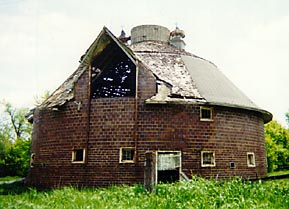
Slayton Farms
Round Barn
Round Barn

This barn is a surviving example of a type of round barn construction mainly found in Iowa, Namely the true round variety built with hollow clay tile walls. The barn was built by Frank Slayton in 1915. It is one of sixteen such barns believed to have been built by the Johnston Brothers Clay Works, a Fort Dodge firm whose model design used two sizes of tile- a smaller tile in the lower story and a larger tile above.
Hollow clay tile round barns have become a distinctive trait of Iowa's round barns compared to those found elsewhere. This era of agricultural prosperity coincided with the state's leadership in clay tile production, when massive efforts were underway to drain her many wetlands in order to expand cultivation in the area's rich soils. Here in Iowa, the hollow clay tile silo was developed by clay tile manufacturers in cooperation with farm building specialists at Iowa State University and it gained immense popularity. In similar fashion , the idea for constructing round hollow tile "silo" barns took hold and encouraged providers to market tile for building construction as well. The Slayton Farm Round Barn exemplified this time of building tile construction.
The roof is of a two-pitch gambrel type with an attractive hay dormer. Two metal roof aerators are located on either side of a central silo. Within the barn, the lower level is arranged in circular fashion around the silo, from which silage was shoveled for feeding the cattle. An overhead track system and bucket for hauling materials is virtually intact and several archeological items used when the barn was in operation are still as they were left when operations at the barn ceased. Above, loft floor joists radiate outward from the silo, first to a curved laminated beam at the interior's center where the stanchions are situated, and from there extend to the outer hollow clay tile exterior walls. An interior ventilation system for the cattle in the lower level carries fresh air from openings up through ventilator pipes running from the loft floor along side the silo wall up to the metal roof ventilators.
The barn is located near the southwest edge of Iowa Falls. The roof is seriously deteriorated and interior damage has occurred because of exposure to the elements. The Iowa Historic Preservation Alliance IHPA listed it as one of the eleven most endangered Iowa National Register properties 2000. The restoration effort has received $13,000 from the REAP/HRDP Grant Program for emergency stabilization. Local fund raising for restoration is underway. Charitable contributions can be made to the Hardin County Historic Preservation Commission Box 35 Iowa Falls, Iowa 50126. It currently is not open to the public, however; a tour can be arranged by calling (515) 648-4570.
 |
|||||||||||||
